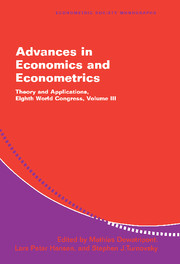Book contents
- Frontmatter
- Contents
- List of Contributors
- Preface
- 1 Contracting Constraints, Credit Markets, and Economic Development
- 2 Factor Models in Large Cross Sections of Time Series
- 3 Macroeconomic Forecasting Using Many Predictors
- “Big Data” Dynamic Factor Models for Macroeconomic Measurement and Forecasting: A Discussion of the Papers by Lucrezia Reichlin and by Mark W. Watson
- 4 How Severe Is the Time-Inconsistency Problem in Monetary Policy?
- 5 New Perspectives on Monetary Policy, Inflation, and the Business Cycle
- Comments on Papers by Stefania Albanesi, V. V. Chari, and Lawrence J. Christiano and by Jordi Galí
- 6 Consumption Smoothing and Extended Families
- 7 Computational Methods for Dynamic Equilibria with Heterogeneous Agents
- Index
3 - Macroeconomic Forecasting Using Many Predictors
Published online by Cambridge University Press: 06 January 2010
- Frontmatter
- Contents
- List of Contributors
- Preface
- 1 Contracting Constraints, Credit Markets, and Economic Development
- 2 Factor Models in Large Cross Sections of Time Series
- 3 Macroeconomic Forecasting Using Many Predictors
- “Big Data” Dynamic Factor Models for Macroeconomic Measurement and Forecasting: A Discussion of the Papers by Lucrezia Reichlin and by Mark W. Watson
- 4 How Severe Is the Time-Inconsistency Problem in Monetary Policy?
- 5 New Perspectives on Monetary Policy, Inflation, and the Business Cycle
- Comments on Papers by Stefania Albanesi, V. V. Chari, and Lawrence J. Christiano and by Jordi Galí
- 6 Consumption Smoothing and Extended Families
- 7 Computational Methods for Dynamic Equilibria with Heterogeneous Agents
- Index
Summary
INTRODUCTION
The past twenty-five years have seen enormous intellectual effort and progress on the development of small-scale macroeconometric models. Indeed, standing in the year 2000, it is not too much of an overstatement to say that the statistical analysis of small macroeconometric models in a stationary environment is largely a completed research topic. In particular, we have complete theories of estimation, inference, and identification in stationary vector autoregressions (VARs). We have accumulated a vast amount of experience using these models for empirical analysis. Identified VARs have become the workhorse models for estimating the dynamic effects of policy changes and for answering questions about the sources of business cycle variability. Both univariate autoregressions and VARs are now standard benchmarks used to evaluate economic forecasts. Although work remains to be done, great progress has been made on the complications associated with nonstationarity, both in the form of the extreme persistence often found in macroeconomic time series and in detecting and modeling instability in economic relations. Threshold autoregressions and Markov switching models successfully capture much of the nonlinearity in macroeconomic relations, at least for countries such as the United States.
Despite this enormous progress, it is also not too much of an overstatement to say that these small-scale macroeconometric models have had little effect on practical macroeconomic forecasting and policymaking. There are several reasons for this, but the most obvious is the inherent defect of small models: they include only a small number of variables. Practical forecasters and policymakers find it useful to extract information from many more series than are typically included in a VAR.
- Type
- Chapter
- Information
- Advances in Economics and EconometricsTheory and Applications, Eighth World Congress, pp. 87 - 114Publisher: Cambridge University PressPrint publication year: 2003
- 29
- Cited by



